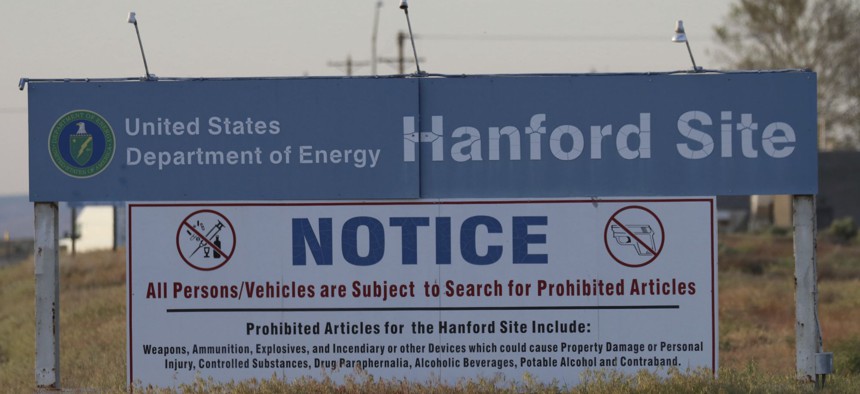What to Make of the Tunnel Collapse at the Hanford Nuclear Cleanup Site

AP Photo / Manuel Valdes Signs are posted by the Hanford Nuclear Reservation in Benton County, Tuesday, May 9, 2017, in Richland, Wash.
The incident is only part of the slow-motion deterioration of one of the country's most contaminated places.
On Tuesday morning, workers at the Hanford Site, a Cold War-era plutonium-production facility turned nuclear-waste cleanup project in Washington, discovered a giant hole in the ground. A tunnel had collapsed.
Because “tunnel collapse” and “nuclear waste” are two phrases you don’t want to see in the same sentence, the news quickly ricocheted around the national media. It’s too early to give a full account of how bad this is. (As of this writing, the Department of Energy says it has detected no radiation release.) But the tunnel, which houses an old railway used to transport irradiated fuel rods to a uranium extraction facility, is hardly the most dangerous place at Hanford.
#HanfordEmergency Update: picture shows 20 ft X 20 ft hole in roof of tunnel. For more info visit https://t.co/o11YHxEAkB #hanfordsite pic.twitter.com/TqEjKucJdB
— Hanford Site (@HanfordSite) May 9, 2017
The most dangerous places are its giant underground tanks, filled with 53 million gallons of radioactive sludge. Over the years, 67 of the 177 tanks have collectively leaked a million gallons—a slow-motion infrastructure collapse that doesn’t lend itself to dramatic photos or headlines. These and are other spills have resulted in 61 square miles of contaminated groundwater at the site.
This has long been the problem with the troubled and oft-delayed cleanup efforts at Hanford. The possibility of true crisis lurks in the background, but not urgently enough to speed things up. A single-shell tank of waste, for example, began leaking in 2013. The Department of Energy has since evaporated liquid from that tank, but has that stopped the leaking permanently? “It’s not clear,” says Randy Bradbury, communication manager at the Washington State Department of Ecology. And in 2012, the inside shell of a double-shell tank—the type that contains the most dangerous high-level radioactive waste—was discovered leaking and not emptied until 2016. As the tanks keep springing leaks, the DOE is left shuffling waste from tank to aging tank.
These long-term tank problems don’t quite have the dramatic value of “tunnel collapse.” The incident this week may end up releasing radiation or it may not—either way, it’s another symptom of the aging and decrepit infrastructure at Hanford. And perhaps it’ll bring some attention to the site’s deeper problems.
The plan to move this high-level radioactive waste out of the tanks has been agonizingly slow. DOE was supposed to “vitrify” the high-level radioactive waste into glass logs and put it in a permanent storage site in Nevada—originally by 1998. That vitrification plant is still under construction. (The Nevada storage site is not even under construction yet, but that’s another story.) Cheryl Whalen, cleanup section manager at the Washington State Department of Ecology, once likened the cleanup efforts to “watching glaciers move.”
The scientists and engineers who built Hanford during the Manhattan Project probably did not give much thought to what would happen to the contaminated site in the future. They had a war to win. Hanford produced the plutonium for the bomb dropped on Nagasaki. And during the Cold War, the site ramped up production to supply the country’s growing nuclear arsenal.
A site once emblematic of U.S. scientific and military might is now a sprawling complex of decaying infrastructure, dotted with nuclear waste. And it’s largely forgotten except by the people who live near it and thus bear the brunt of its potential disasters.
Sarah Zhang is a staff writer for The Atlantic, where this article was originally published.
NEXT STORY: The Poetry of Small-Town Mythologies in Arizona





